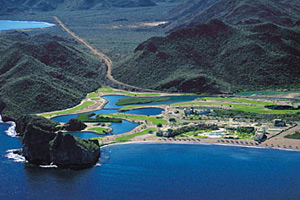Mexico Beachfront Homes are Luring U.S. Investors
 Craig Harris - Gannett News Service Craig Harris - Gannett News Service


| | Loreto Bay, Baja California, Mexico |
With its rugged mountains, crystal blue sea and schools of dolphins swimming offshore, Mexico's Loreto Bay last year enticed Scottsdale, Ariz., investor Ryan Ansell to buy a second home there.

Ansell, 31, was so impressed with the planned 6,000-unit development 700 miles from the U.S. border that he rounded up investors to buy nine more homes.

He is among a growing number of Americans who during the past five years have invested in real estate on or near Mexican beaches. Many are baby boomers who have used their savings or equity from rising U.S. home values to buy across the border.

Beachfront property in Mexico is far cheaper than in California and can be reached in a relatively short drive or within a few hours by air for people who live in the southwestern United States.

Developers say home values are appreciating, buyers can rent their properties for additional income and the homes provide an additional tax deduction. But the growth also is putting pressure on local infrastructure, especially the water supply.

Bruce Greenberg of Tucson, Ariz., an appraiser who specializes in real estate in Mexico, said residential investments in Puerto Penasco, commonly called Rocky Point and a popular vacation spot for Arizonans, surpassed $500 million last year.

"Americans are feeling welcome and safe in Mexico and especially in (the Mexican state of) Sonora," Greenberg said. "Sonora has really stepped up to put in safeguards for consumer protection."

Greenberg said the Mexican government under President Vicente Fox has cracked down on corruption and real estate bribes to generate more real estate business and create a safer environment.

He also said U.S. companies are selling title insurance, which provides another layer of protection, and major U.S. banks have entered the real estate market in Mexico.

However, Greenberg said a lack of verifiable sales data, such as public records, could pose problems. Also, some Americans have lost their homes because of questionable business practices.

Between 500,000 to 1.5 million Americans have homes in Mexico, said Jeff Hornberger, manager of international market development for the National Association of Realtors. The precise number of owners is difficult to measure because of a lack of data, he said.

"We know the numbers are going up, and a lot of Americans are buying second homes," he said. "The vast majority are not having problems, but it's a market where you want to do your due diligence. You need to move a little more cautiously."

To buy along the Mexican beachfronts, Americans must use a renewable 50-year Mexican bank trust because foreigners are barred from direct ownership of property within 50 kilometers (about 31 miles) of the coastline.

"The bank holds the property, and you are the beneficiary. That's your legal title. You have all the rights to sell whenever you want," said Beth Lindeman at Great Southwest Mortgage in Scottsdale. She assists with financing real estate purchases in Mexico.

Luis Iribe, director of tourism for Sonora, said most Mexicans welcome the U.S. investment, adding that the new developments have produced jobs and economic benefits. However, Iribe said having adequate fresh water is a challenge in Rocky Point.

"Every development must have its own resource of water or treatment," he said.

Another popular area is Loreto Bay, where Jim Grogan's Scottsdale-based Loreto Bay Co. is developing 3,000 acres with properties ranging from 1,300-square-foot homes in the low $300,000 range to 3,000-square-foot homes for more than $1 million.

Many buyers are baby boomers who want an investment for their families.

"They can bring their grandkids and kids to the beach, and it's much more appealing than stock," Grogan said.

Tom Maddock, a hydrology professor at the University of Arizona, said finding an adequate water supply will be a major challenge. "The present water supply is trouble .... Pumps fail, and there are maintenance problems," he said. "There is a limited freshwater supply."

Maddock said the community could sustain limited growth, but he's concerned about the planned build-out of 6,000 homes. "The problem is they just don't have the infrastructure to support it," Maddock said. "It's a nice little town. I would hate to see it grow."

However, growth seems inevitable. |



